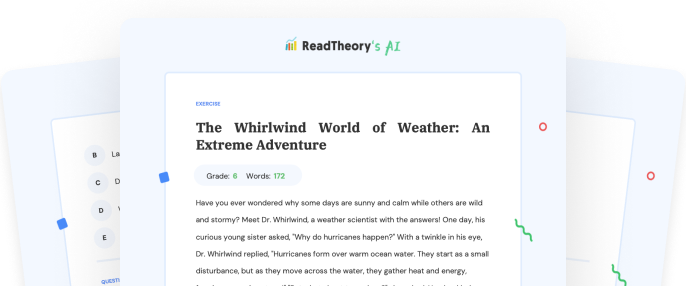Transform Your Teaching
with AI-Powered Worksheets
With ReadTheory’s Instant Worksheet Builder, you can create engaging, grade-appropriate worksheets tailored to your students in minutes. Spark curiosity, save time, and empower critical thinking with AI-powered tools designed for teachers like you.


The Evolution and Impact of Architecture
Architecture, the art and science of designing and constructing buildings, has evolved considerably since ancient times. The earliest structures were built for practical purposes, using available materials such as stone and wood. However, as civilizations advanced, architectural designs became more sophisticated, reflecting cultural values, religious beliefs, and technological progress.
For instance, the Ancient Greeks developed the Classical style, characterized by symmetry, proportion, and columned structures like the Parthenon. The Romans adapted this style, adding engineering innovations such as the arch and dome, seen in the Colosseum and the Pantheon.
The Middle Ages brought the Gothic style, with its pointed arches, ribbed vaults, and flying buttresses, as exemplified by the Notre Dame. The Renaissance revived Classical principles, but with a new emphasis on individual expression and scientific understanding of perspective, seen in St. Peter's Basilica.
The 20th Century ushered in Modernism, a break from historic styles, favoring functionality and simplicity. Architects like Frank Lloyd Wright, with his organic architecture, and Le Corbusier, a pioneer of Brutalism, left significant imprints on modern architecture.
Architecture is not just about constructing buildings; it's about shaping the environment and influencing how we live. It's about sustainability, creating buildings that are energy-efficient and in harmony with their surroundings. Moreover, it's about aesthetic appeal, evoking emotions, and enhancing our everyday experiences.
In conclusion, architecture transcends time and culture, reflecting societal shifts and technological advancements. It continues to evolve, challenging our perceptions of space and design, and profoundly impacting our lives and societies.
Question 1
Which ancient civilization is known for developing the Classical style of architecture?
Egyptians
Romans
Babylonians
Ancient Greeks
Mayans
Question 2
What significant advancement did the Romans bring to architecture?
Pyramids
Pointed Arches
The Arch and Dome
Flying Buttresses
Ziggurats
Question 3
What was a notable feature of Gothic architecture?
Symmetry
Pointed Arches
Domed Roofs
Pillars
Flat Roofs
Question 4
Who was a pioneer of Brutalism in the 20th century?
Michelangelo
Frank Lloyd Wright
Le Corbusier
Christopher Wren
I.M.Pei
Question 5
What is one of the modern concerns of architecture?
Aesthetic Appeal
Cultural Reflection
Sustainability
Historical Accuracy
Religious Appropriation
 or share via
or share via

Assign the ReadTheory pretest to determine students' reading levels.

Why Teachers Love
Instant Worksheet Builder?

Tailored Content for Every Student
Craft worksheets with passages and multiple-choice questions customized to your chosen topic and grade level, ensuring relevance and engagement.

Save Hours
of Prep Time
Our AI, Lexi, generates complete worksheets—passages, questions, and answers—in minutes, freeing you to focus on teaching, not planning.

Standards-Aligned Learning
Every worksheet is designed to boost reading comprehension and critical thinking, aligning seamlessly with State Standards to help your students shine.
Personalized teaching
for personalized learning
Browse worksheets created and refined by educators using Lexi—your source for inspiration and ready-to-use resources.


ReadTheory is free for Teachers to use.
Join thousands of educators using ReadTheory for free. Sign up today and start creating in just minutes!





